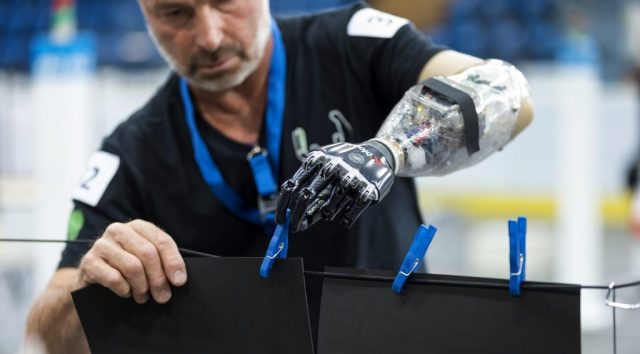
The event is called the Cybathlon because “Cyborg Olympics” was bound to get someone sued, and the organizers didn’t want to give the impression that to compete you had to be Seven of Nine. This event is all about bionics and prosthetics and other powered assistive devices. “Although people are at the centre of our event, technology also plays a relatively large role,” said founder Robert Reiner in an interview. It’s meant to showcase the strengths — and weaknesses — of powered assistive tech, by testing how it does with accuracy, agility, and ease of use. Where sports often forbid assistive technologies that improve performance, says Reiner, “We allow technology — we have to have technology.”

Only about a quarter of the tech being fielded here is from companies. The majority of teams are “research labs from universities,” and bring with them mobility-impaired athletes who will be using their latest, sometimes prototype-level mobility devices. This year there will be powered exoskeletons, bionic arms and legs, recumbent bicyclists who ride powered by functional electrical stimulation (FES), and even a Swedish team using a prosthetic implanted into the patient’s bone.
The brain-computer interface (BCI) race is novel. It tests the reliability and precision of BCIs as pilots guide an avatar through a virtual obstacle course with their brains. Rigs can use EEGs or near-IR spectroscopy, and participants can’t use anything other than their minds. They can’t use visual or muscular signals to drive their BCI, and rigs have to be able to scrub out “muscle and eye movement artifacts.” Clearing one’s mind, as in meditation, lets their avatar “benefit from a higher velocity” — Zen out and you speed up. Incorrect commands result in a halt.

The Cybathlon has its standard running track and even a bicycle racecourse for recumbent bikes. Where the Olympics and Paralympics are focused on sports, though, the Cybathlon also built racecourses to evoke specific aspects of daily life. The courses are designed around the idea that prosthetics and bionic aids should serve their pilots (that’s what the Cybathlon is calling its participants: pilots) just as well in their everyday surroundings as they do in the calibrated and sterile environment of a lab. While scientific rigor might make for the best measurements, ultimately we have to step outside the lab to see how the devices fare in the wild.
And in some cases they really do mean “in the wild.” One racecourse is a stepping-stone pathway that forces the user to do crossover footwork, designed to mimic pathfinding in a forest. Imagine hopping from exposed root to root. Now imagine being a double below-the-knee amputee and doing that. Pilots really need to be able to trust their prosthetics. These are not half-measures; the Cybathlon is meant to put mobility aids through intense field tests, and come out with an understanding of what works and what doesn’t. There is valuable information in the failure modes of entrants’ prosthetics, just as there is in the ways they excel.
Probably the best part of the event is their brilliant implementation of household environments as obstacle courses. Stairs, doorways, keys, dinner — all these things can become mountains, morale-draining impediments to normalcy that people with disabilities just have to deal with. So the Cybathlon organizers built a benchmark household “racecourse” for athletes to navigate.

Far from being a perfectly level court or track, it’s made to evoke a standard European home, complete with stairs down to a basement populated with sports equipment and storage detritus, and a couch and kitchenware from IKEA. They’ve benchmarked the exact opening movement for a standard jam jar (it’s 4.0 Nm, for the curious). The whole thing is marked up like Mythbusters, with blue as the official color for things athletes are meant to handle with their bionics. One of the tasks in the prosthetic arm race involves cutting a slice of bread out of an actual loaf, and then popping the jam jar to spread it on the bread. Another involves lugging groceries and a crate of bottles up from the basement.
Sending trained athletes through a basement carrying groceries might seem pointlessly mundane, but this event is designed to put prosthetics through a real-world acid test. It’s designed around people, and what they actually do in their day-to-day. The technology has to serve its user intuitively and accurately to succeed. It is a testament to mechanical, electrical, and medical engineering that these devices don’t turn the Cybathlon into one giant game of QWOP.
Accessibility is big right now. The question of empowering people with disabilities is about more than making things accessible, though; it’s also about getting past the barriers to access that exist anyway. This event means to make sure the buck doesn’t stop at curb cutting and reserved blue-painted parking spots. “The world does have barriers,” says Riener, “and you can’t just make them disappear – there are hills, forest paths and so forth.” People have lives to live. Far from letting those things remain obstructions, the Cybathlon aims to give everyone the chance to boldly go where no mobility-impaired person has gone before.

